Information Technology in Business - LSC, Suffolk - Jan 2022
VerifiedAdded on 2023/06/15
|11
|3102
|243
Report
AI Summary
This report provides an overview of Information Technology (IT) and its applications in business, focusing on HSBC Holdings as a case study. It covers various types of application software used by businesses, ethical and social issues associated with IT, different types of networking technologies (LAN, MAN, WAN), the impact of artificial intelligence (AI) on business operations, and the stages of the software development life cycle. The report highlights the importance of IT in modern business, emphasizing efficiency, security, and ethical considerations. It also discusses how AI can enhance productivity and reduce errors, while networking technologies facilitate communication and data exchange within and between organizations. The analysis draws from literature review and provides practical insights into the role of IT in a global financial institution like HSBC.
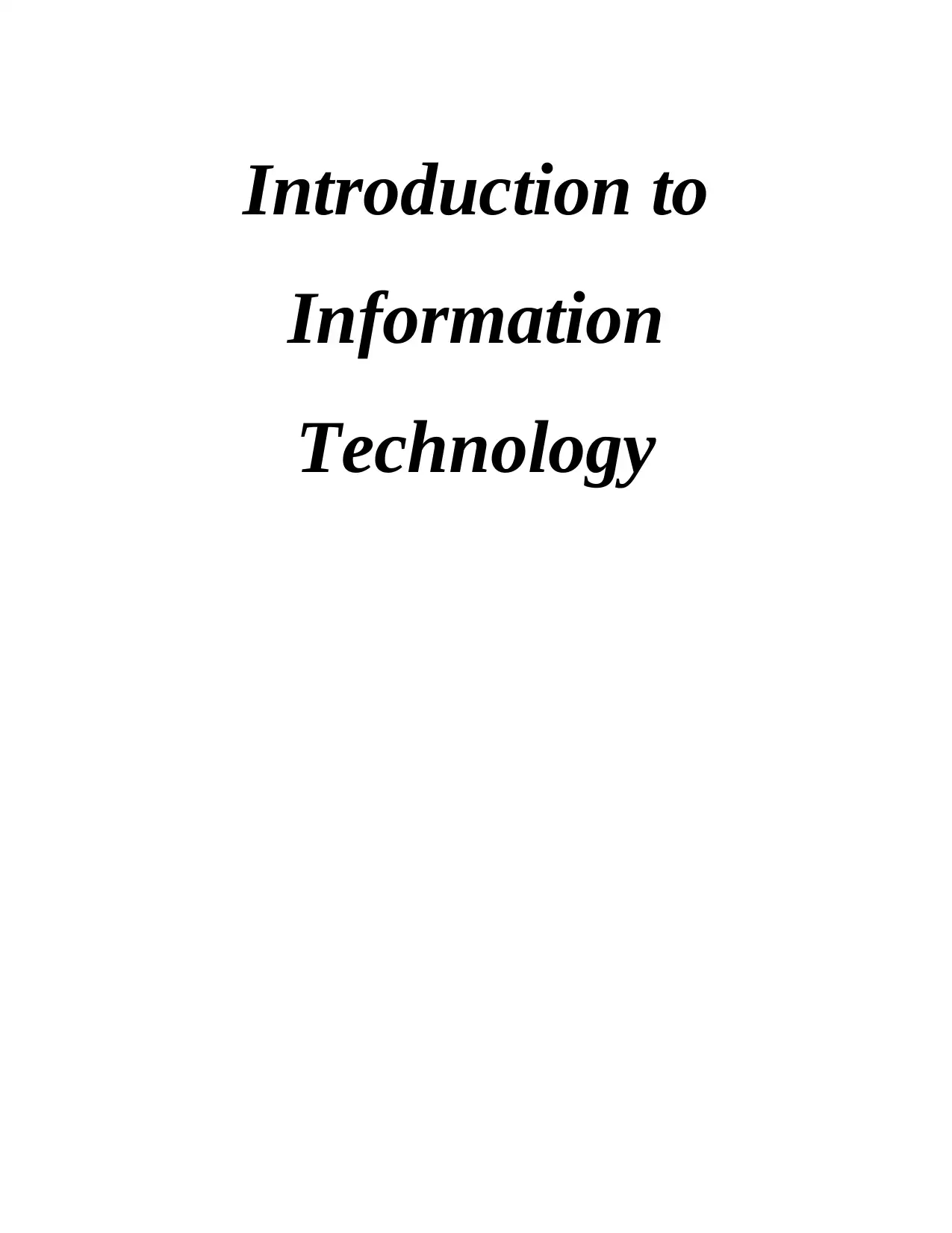
Introduction to
Information
Technology
Information
Technology
Paraphrase This Document
Need a fresh take? Get an instant paraphrase of this document with our AI Paraphraser
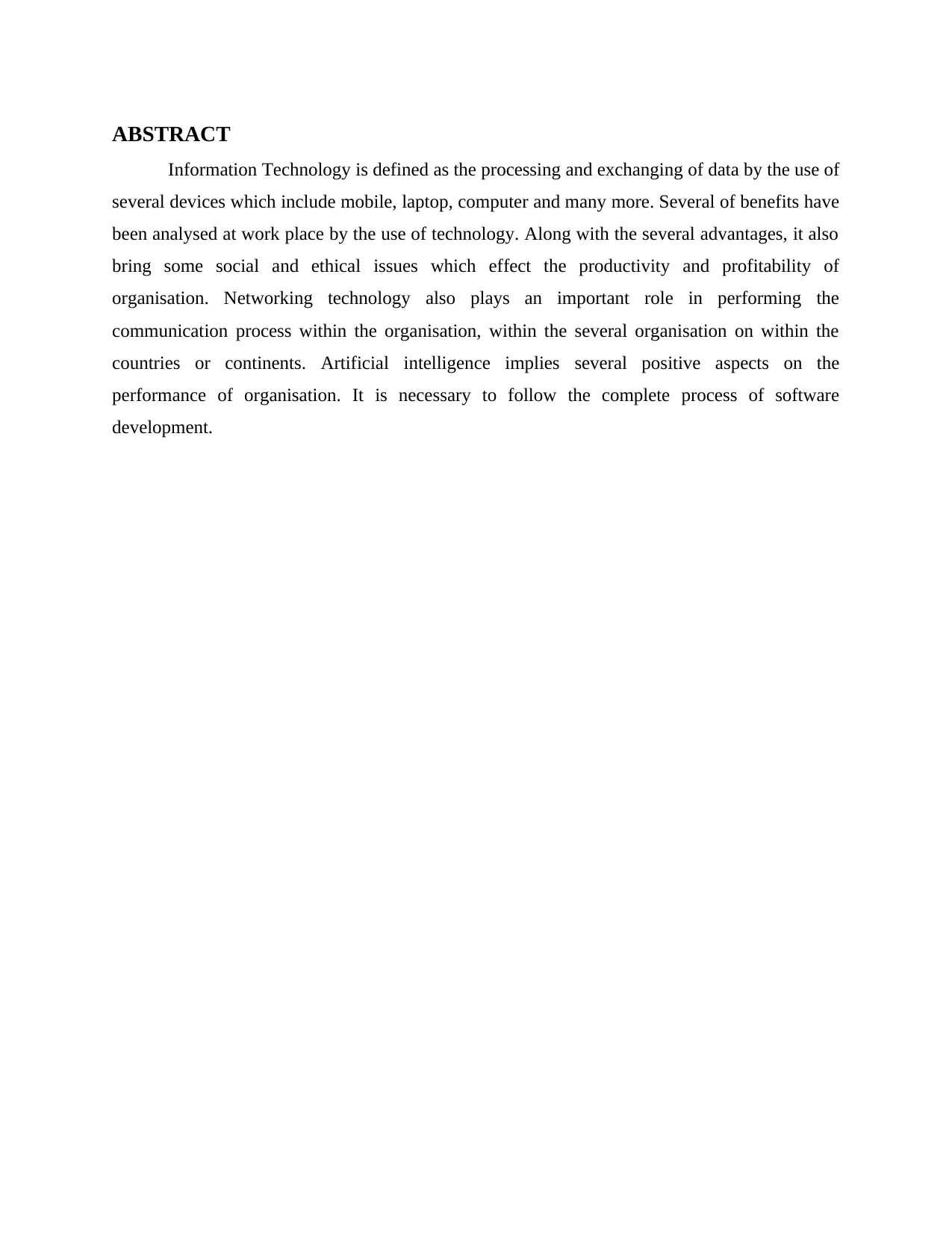
ABSTRACT
Information Technology is defined as the processing and exchanging of data by the use of
several devices which include mobile, laptop, computer and many more. Several of benefits have
been analysed at work place by the use of technology. Along with the several advantages, it also
bring some social and ethical issues which effect the productivity and profitability of
organisation. Networking technology also plays an important role in performing the
communication process within the organisation, within the several organisation on within the
countries or continents. Artificial intelligence implies several positive aspects on the
performance of organisation. It is necessary to follow the complete process of software
development.
Information Technology is defined as the processing and exchanging of data by the use of
several devices which include mobile, laptop, computer and many more. Several of benefits have
been analysed at work place by the use of technology. Along with the several advantages, it also
bring some social and ethical issues which effect the productivity and profitability of
organisation. Networking technology also plays an important role in performing the
communication process within the organisation, within the several organisation on within the
countries or continents. Artificial intelligence implies several positive aspects on the
performance of organisation. It is necessary to follow the complete process of software
development.
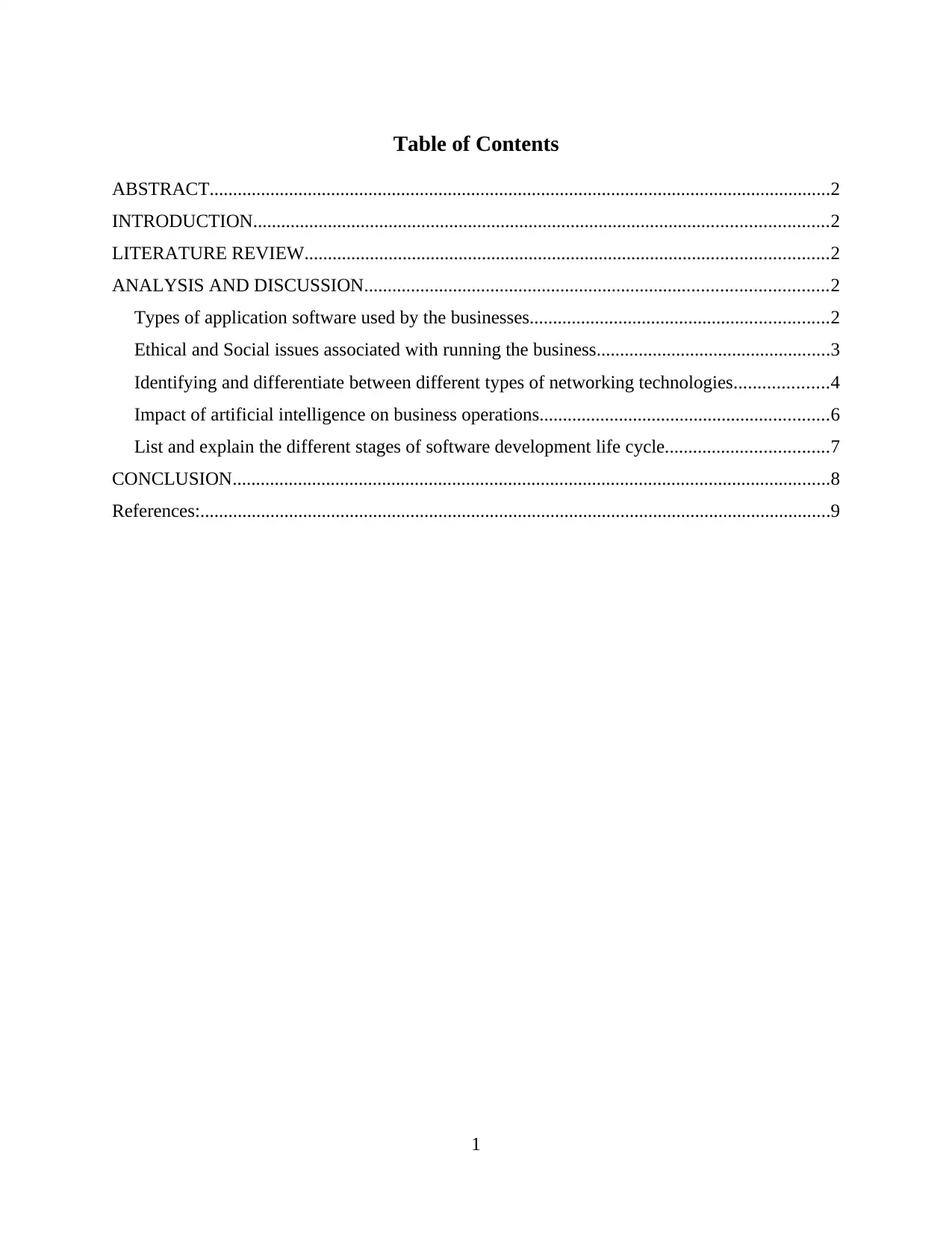
Table of Contents
ABSTRACT.....................................................................................................................................2
INTRODUCTION...........................................................................................................................2
LITERATURE REVIEW................................................................................................................2
ANALYSIS AND DISCUSSION...................................................................................................2
Types of application software used by the businesses................................................................2
Ethical and Social issues associated with running the business..................................................3
Identifying and differentiate between different types of networking technologies....................4
Impact of artificial intelligence on business operations..............................................................6
List and explain the different stages of software development life cycle...................................7
CONCLUSION................................................................................................................................8
References:.......................................................................................................................................9
1
ABSTRACT.....................................................................................................................................2
INTRODUCTION...........................................................................................................................2
LITERATURE REVIEW................................................................................................................2
ANALYSIS AND DISCUSSION...................................................................................................2
Types of application software used by the businesses................................................................2
Ethical and Social issues associated with running the business..................................................3
Identifying and differentiate between different types of networking technologies....................4
Impact of artificial intelligence on business operations..............................................................6
List and explain the different stages of software development life cycle...................................7
CONCLUSION................................................................................................................................8
References:.......................................................................................................................................9
1
⊘ This is a preview!⊘
Do you want full access?
Subscribe today to unlock all pages.

Trusted by 1+ million students worldwide
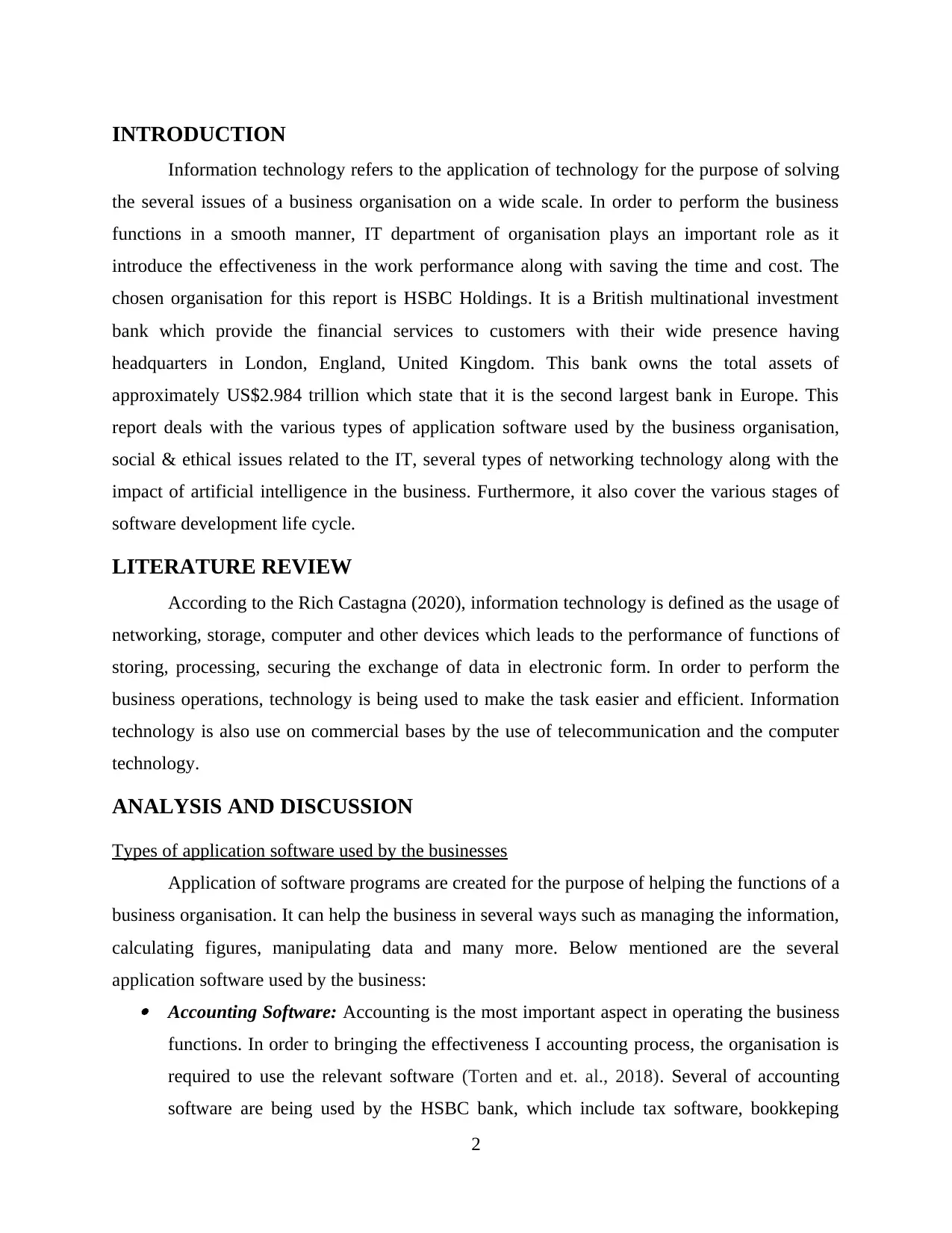
INTRODUCTION
Information technology refers to the application of technology for the purpose of solving
the several issues of a business organisation on a wide scale. In order to perform the business
functions in a smooth manner, IT department of organisation plays an important role as it
introduce the effectiveness in the work performance along with saving the time and cost. The
chosen organisation for this report is HSBC Holdings. It is a British multinational investment
bank which provide the financial services to customers with their wide presence having
headquarters in London, England, United Kingdom. This bank owns the total assets of
approximately US$2.984 trillion which state that it is the second largest bank in Europe. This
report deals with the various types of application software used by the business organisation,
social & ethical issues related to the IT, several types of networking technology along with the
impact of artificial intelligence in the business. Furthermore, it also cover the various stages of
software development life cycle.
LITERATURE REVIEW
According to the Rich Castagna (2020), information technology is defined as the usage of
networking, storage, computer and other devices which leads to the performance of functions of
storing, processing, securing the exchange of data in electronic form. In order to perform the
business operations, technology is being used to make the task easier and efficient. Information
technology is also use on commercial bases by the use of telecommunication and the computer
technology.
ANALYSIS AND DISCUSSION
Types of application software used by the businesses
Application of software programs are created for the purpose of helping the functions of a
business organisation. It can help the business in several ways such as managing the information,
calculating figures, manipulating data and many more. Below mentioned are the several
application software used by the business: Accounting Software: Accounting is the most important aspect in operating the business
functions. In order to bringing the effectiveness I accounting process, the organisation is
required to use the relevant software (Torten and et. al., 2018). Several of accounting
software are being used by the HSBC bank, which include tax software, bookkeping
2
Information technology refers to the application of technology for the purpose of solving
the several issues of a business organisation on a wide scale. In order to perform the business
functions in a smooth manner, IT department of organisation plays an important role as it
introduce the effectiveness in the work performance along with saving the time and cost. The
chosen organisation for this report is HSBC Holdings. It is a British multinational investment
bank which provide the financial services to customers with their wide presence having
headquarters in London, England, United Kingdom. This bank owns the total assets of
approximately US$2.984 trillion which state that it is the second largest bank in Europe. This
report deals with the various types of application software used by the business organisation,
social & ethical issues related to the IT, several types of networking technology along with the
impact of artificial intelligence in the business. Furthermore, it also cover the various stages of
software development life cycle.
LITERATURE REVIEW
According to the Rich Castagna (2020), information technology is defined as the usage of
networking, storage, computer and other devices which leads to the performance of functions of
storing, processing, securing the exchange of data in electronic form. In order to perform the
business operations, technology is being used to make the task easier and efficient. Information
technology is also use on commercial bases by the use of telecommunication and the computer
technology.
ANALYSIS AND DISCUSSION
Types of application software used by the businesses
Application of software programs are created for the purpose of helping the functions of a
business organisation. It can help the business in several ways such as managing the information,
calculating figures, manipulating data and many more. Below mentioned are the several
application software used by the business: Accounting Software: Accounting is the most important aspect in operating the business
functions. In order to bringing the effectiveness I accounting process, the organisation is
required to use the relevant software (Torten and et. al., 2018). Several of accounting
software are being used by the HSBC bank, which include tax software, bookkeping
2
Paraphrase This Document
Need a fresh take? Get an instant paraphrase of this document with our AI Paraphraser

software, payroll software and many others. Best accounting software are used for the
purpose of making efficient use of time, tax filing, cash flow etc. HSBC bank have to
process with the lots of figures. Hence, they are required to select the best software as per
their needs. Time tracking software: This software is useful for organisation as it leads to the
managing the time in a proper manner. Mangers are required to keep an eye or track the
operations of organisations by managing the time. This software help the same. The
management of HSBC bank is using this software for the purpose of knowing about the
time management of organisation (Toyama, K., 2018). By this application, the
organisation know where they are spending too much and too little time along with
analysing the free time. It help the HSBC bank to use the free time in the business
operations.
Customer Relationship management Software: Customers are consider as the King of a
business as all the business organisations are performed only for the purpose of providing
products and services to their customers. Hence, it is necessary fro thr business
organisation to develop a healthy relationship with them. HSBC bank is using CRM tool
in order to better analysing the ways or methods in which their business act with its
culture base. This software is implying an important and valuable assistance to the
employees of HSBC bank which help them in understanding their customers in a better
way.
Ethical and Social issues associated with running the business
Ethical Issues
Information technology include all those elements which are being used to store,
manipulate and fetch the informations at a minimum level. Advancement in the IT sector implies
the knowledge of privacy and security to the management of organisation. Some of ethical
issues in the context of HSBC Holdings are given below: Personal Privacy: HSBC Holdings is using the technology on daily basis by using
internet, banking, mobile banking and many more. For the same purpose, the
management is required to work with the personal details and information of customers.
It is the main task for the management to maintain the privacy of their customers and
3
purpose of making efficient use of time, tax filing, cash flow etc. HSBC bank have to
process with the lots of figures. Hence, they are required to select the best software as per
their needs. Time tracking software: This software is useful for organisation as it leads to the
managing the time in a proper manner. Mangers are required to keep an eye or track the
operations of organisations by managing the time. This software help the same. The
management of HSBC bank is using this software for the purpose of knowing about the
time management of organisation (Toyama, K., 2018). By this application, the
organisation know where they are spending too much and too little time along with
analysing the free time. It help the HSBC bank to use the free time in the business
operations.
Customer Relationship management Software: Customers are consider as the King of a
business as all the business organisations are performed only for the purpose of providing
products and services to their customers. Hence, it is necessary fro thr business
organisation to develop a healthy relationship with them. HSBC bank is using CRM tool
in order to better analysing the ways or methods in which their business act with its
culture base. This software is implying an important and valuable assistance to the
employees of HSBC bank which help them in understanding their customers in a better
way.
Ethical and Social issues associated with running the business
Ethical Issues
Information technology include all those elements which are being used to store,
manipulate and fetch the informations at a minimum level. Advancement in the IT sector implies
the knowledge of privacy and security to the management of organisation. Some of ethical
issues in the context of HSBC Holdings are given below: Personal Privacy: HSBC Holdings is using the technology on daily basis by using
internet, banking, mobile banking and many more. For the same purpose, the
management is required to work with the personal details and information of customers.
It is the main task for the management to maintain the privacy of their customers and
3
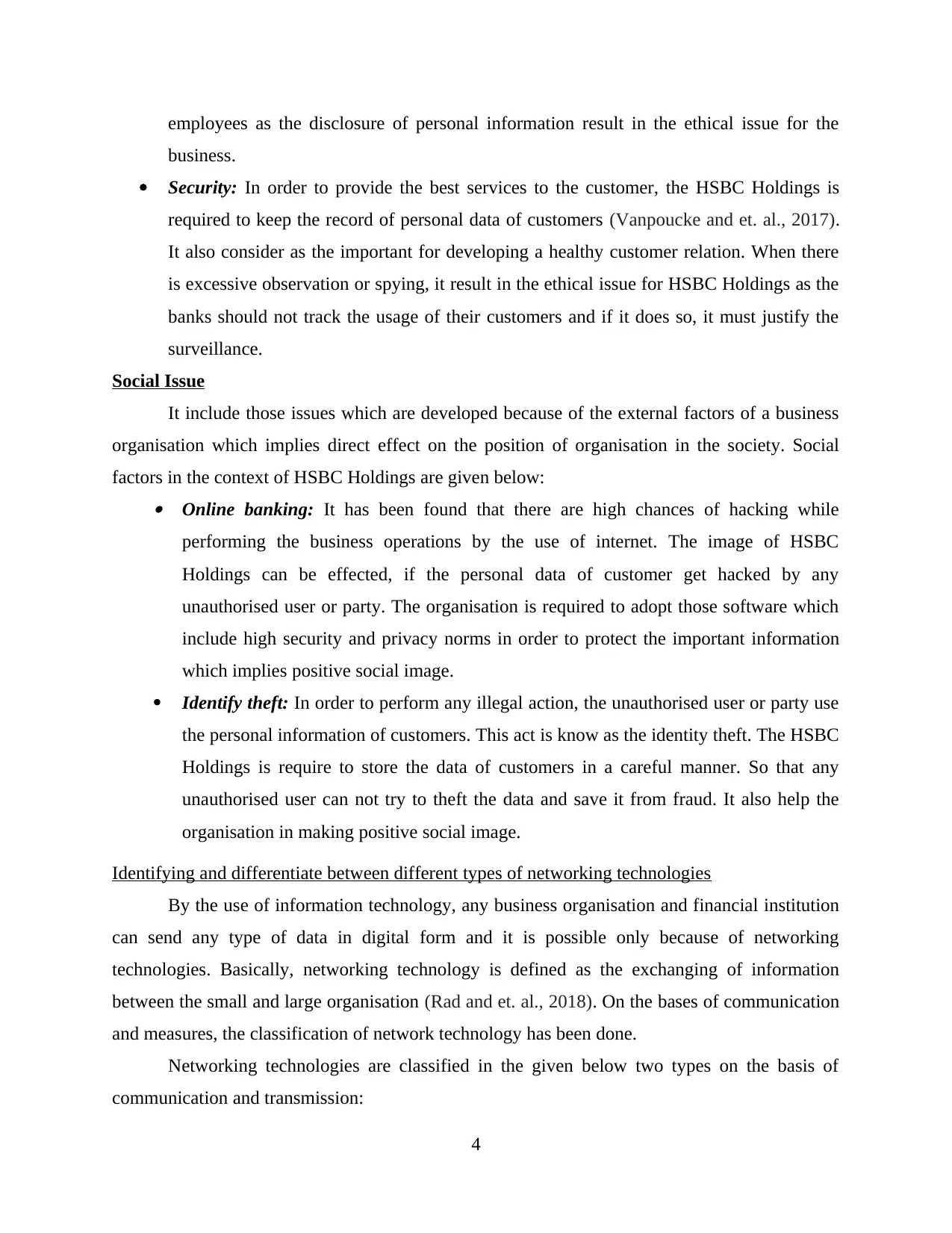
employees as the disclosure of personal information result in the ethical issue for the
business.
Security: In order to provide the best services to the customer, the HSBC Holdings is
required to keep the record of personal data of customers (Vanpoucke and et. al., 2017).
It also consider as the important for developing a healthy customer relation. When there
is excessive observation or spying, it result in the ethical issue for HSBC Holdings as the
banks should not track the usage of their customers and if it does so, it must justify the
surveillance.
Social Issue
It include those issues which are developed because of the external factors of a business
organisation which implies direct effect on the position of organisation in the society. Social
factors in the context of HSBC Holdings are given below: Online banking: It has been found that there are high chances of hacking while
performing the business operations by the use of internet. The image of HSBC
Holdings can be effected, if the personal data of customer get hacked by any
unauthorised user or party. The organisation is required to adopt those software which
include high security and privacy norms in order to protect the important information
which implies positive social image.
Identify theft: In order to perform any illegal action, the unauthorised user or party use
the personal information of customers. This act is know as the identity theft. The HSBC
Holdings is require to store the data of customers in a careful manner. So that any
unauthorised user can not try to theft the data and save it from fraud. It also help the
organisation in making positive social image.
Identifying and differentiate between different types of networking technologies
By the use of information technology, any business organisation and financial institution
can send any type of data in digital form and it is possible only because of networking
technologies. Basically, networking technology is defined as the exchanging of information
between the small and large organisation (Rad and et. al., 2018). On the bases of communication
and measures, the classification of network technology has been done.
Networking technologies are classified in the given below two types on the basis of
communication and transmission:
4
business.
Security: In order to provide the best services to the customer, the HSBC Holdings is
required to keep the record of personal data of customers (Vanpoucke and et. al., 2017).
It also consider as the important for developing a healthy customer relation. When there
is excessive observation or spying, it result in the ethical issue for HSBC Holdings as the
banks should not track the usage of their customers and if it does so, it must justify the
surveillance.
Social Issue
It include those issues which are developed because of the external factors of a business
organisation which implies direct effect on the position of organisation in the society. Social
factors in the context of HSBC Holdings are given below: Online banking: It has been found that there are high chances of hacking while
performing the business operations by the use of internet. The image of HSBC
Holdings can be effected, if the personal data of customer get hacked by any
unauthorised user or party. The organisation is required to adopt those software which
include high security and privacy norms in order to protect the important information
which implies positive social image.
Identify theft: In order to perform any illegal action, the unauthorised user or party use
the personal information of customers. This act is know as the identity theft. The HSBC
Holdings is require to store the data of customers in a careful manner. So that any
unauthorised user can not try to theft the data and save it from fraud. It also help the
organisation in making positive social image.
Identifying and differentiate between different types of networking technologies
By the use of information technology, any business organisation and financial institution
can send any type of data in digital form and it is possible only because of networking
technologies. Basically, networking technology is defined as the exchanging of information
between the small and large organisation (Rad and et. al., 2018). On the bases of communication
and measures, the classification of network technology has been done.
Networking technologies are classified in the given below two types on the basis of
communication and transmission:
4
⊘ This is a preview!⊘
Do you want full access?
Subscribe today to unlock all pages.

Trusted by 1+ million students worldwide
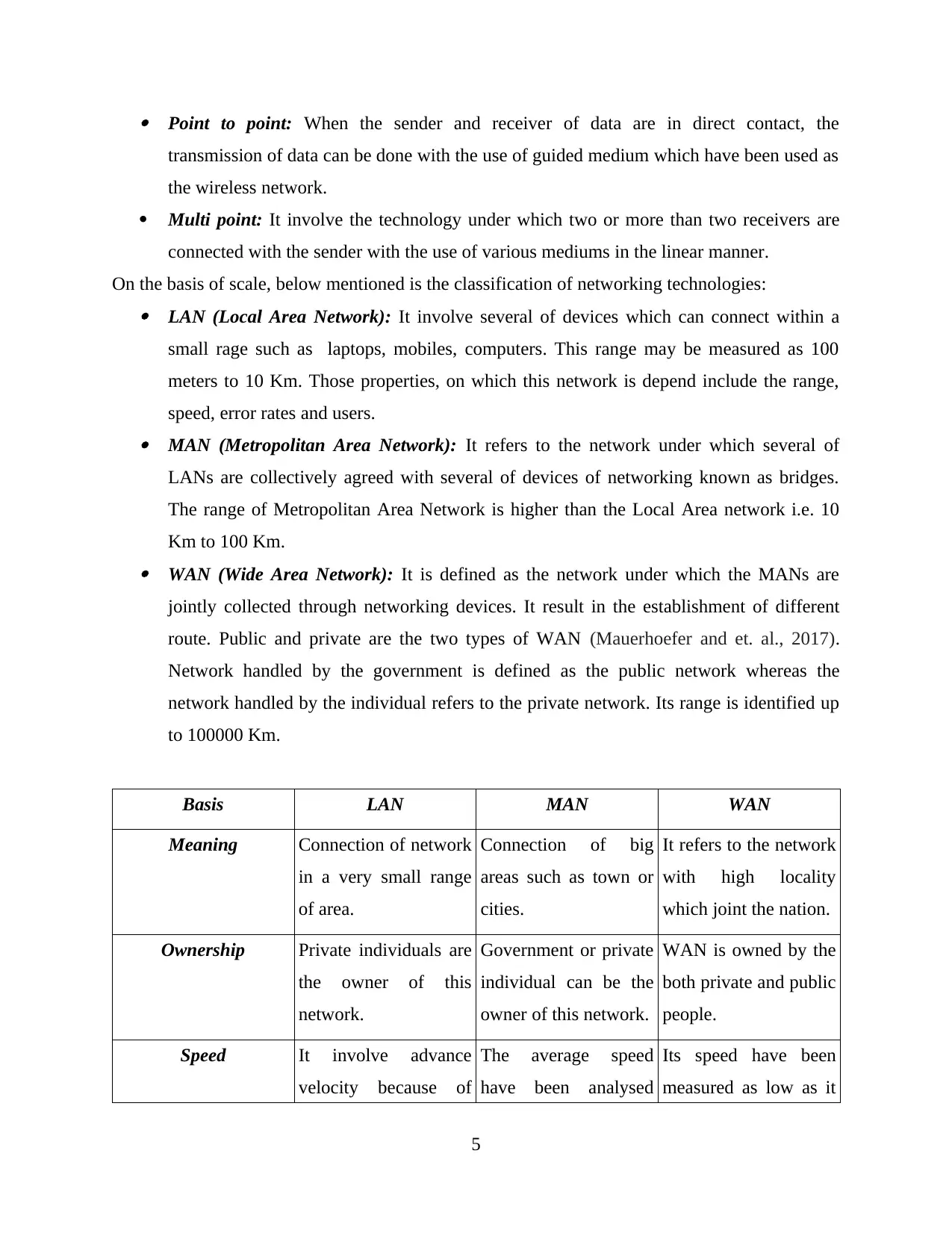
Point to point: When the sender and receiver of data are in direct contact, the
transmission of data can be done with the use of guided medium which have been used as
the wireless network.
Multi point: It involve the technology under which two or more than two receivers are
connected with the sender with the use of various mediums in the linear manner.
On the basis of scale, below mentioned is the classification of networking technologies: LAN (Local Area Network): It involve several of devices which can connect within a
small rage such as laptops, mobiles, computers. This range may be measured as 100
meters to 10 Km. Those properties, on which this network is depend include the range,
speed, error rates and users. MAN (Metropolitan Area Network): It refers to the network under which several of
LANs are collectively agreed with several of devices of networking known as bridges.
The range of Metropolitan Area Network is higher than the Local Area network i.e. 10
Km to 100 Km. WAN (Wide Area Network): It is defined as the network under which the MANs are
jointly collected through networking devices. It result in the establishment of different
route. Public and private are the two types of WAN (Mauerhoefer and et. al., 2017).
Network handled by the government is defined as the public network whereas the
network handled by the individual refers to the private network. Its range is identified up
to 100000 Km.
Basis LAN MAN WAN
Meaning Connection of network
in a very small range
of area.
Connection of big
areas such as town or
cities.
It refers to the network
with high locality
which joint the nation.
Ownership Private individuals are
the owner of this
network.
Government or private
individual can be the
owner of this network.
WAN is owned by the
both private and public
people.
Speed It involve advance
velocity because of
The average speed
have been analysed
Its speed have been
measured as low as it
5
transmission of data can be done with the use of guided medium which have been used as
the wireless network.
Multi point: It involve the technology under which two or more than two receivers are
connected with the sender with the use of various mediums in the linear manner.
On the basis of scale, below mentioned is the classification of networking technologies: LAN (Local Area Network): It involve several of devices which can connect within a
small rage such as laptops, mobiles, computers. This range may be measured as 100
meters to 10 Km. Those properties, on which this network is depend include the range,
speed, error rates and users. MAN (Metropolitan Area Network): It refers to the network under which several of
LANs are collectively agreed with several of devices of networking known as bridges.
The range of Metropolitan Area Network is higher than the Local Area network i.e. 10
Km to 100 Km. WAN (Wide Area Network): It is defined as the network under which the MANs are
jointly collected through networking devices. It result in the establishment of different
route. Public and private are the two types of WAN (Mauerhoefer and et. al., 2017).
Network handled by the government is defined as the public network whereas the
network handled by the individual refers to the private network. Its range is identified up
to 100000 Km.
Basis LAN MAN WAN
Meaning Connection of network
in a very small range
of area.
Connection of big
areas such as town or
cities.
It refers to the network
with high locality
which joint the nation.
Ownership Private individuals are
the owner of this
network.
Government or private
individual can be the
owner of this network.
WAN is owned by the
both private and public
people.
Speed It involve advance
velocity because of
The average speed
have been analysed
Its speed have been
measured as low as it
5
Paraphrase This Document
Need a fresh take? Get an instant paraphrase of this document with our AI Paraphraser

less range of area. due to the courage of
high range as
compared to the LAN
i.e. 100 Km.
cover high range of
distance.
Used for This network is mostly
used in the schools and
colleges.
This network is
expanded in the cities
and towns.
This network is used
in all over the
countries and
continents.
Allows It include the set of
individuals as it allows
the process of
communication.
It primarily allows
several computers to
act coinciding (Xiang,
Z., 2018).
It allows large units of
computers to passing
the information at
same time.
Fault tolerance It include high break
allowances.
Less fault endurance
has been analysed as
compare to LAN.
It involve the fault
tolerance as compare
to LAN and MAN.
(Lloyd, I., 2020)
Impact of artificial intelligence on business operations.
It has been found that artificial intelligence is constantly transforming the world in which
people live. It leads to the development of efficiency at work place. AI is defined as the science
and engineering which makes the machines intelligent by the use of computer program. Several
of impact of artificial intelligence on the business operations of HSBC Holdings are given below: Saving of time and money: HSBC Holdings is using several of machines by using
advance technology which leads to the saving of time such as ATM machine, cash
deposit machine and many more. These machines are intelligent as the human and bring
the effectiveness in the work by avoiding any mistake which is generally done by the
human beings. These machines are working 24*7 without taking any break (Lloyd, I.,
2020). Reducing errors: Humans can do any mistake while performing the business operations
but it has been found that the machinery always reduce the chances of errors. AI take a
little time while doing calculation and implies the correct answer. In the context of
6
high range as
compared to the LAN
i.e. 100 Km.
cover high range of
distance.
Used for This network is mostly
used in the schools and
colleges.
This network is
expanded in the cities
and towns.
This network is used
in all over the
countries and
continents.
Allows It include the set of
individuals as it allows
the process of
communication.
It primarily allows
several computers to
act coinciding (Xiang,
Z., 2018).
It allows large units of
computers to passing
the information at
same time.
Fault tolerance It include high break
allowances.
Less fault endurance
has been analysed as
compare to LAN.
It involve the fault
tolerance as compare
to LAN and MAN.
(Lloyd, I., 2020)
Impact of artificial intelligence on business operations.
It has been found that artificial intelligence is constantly transforming the world in which
people live. It leads to the development of efficiency at work place. AI is defined as the science
and engineering which makes the machines intelligent by the use of computer program. Several
of impact of artificial intelligence on the business operations of HSBC Holdings are given below: Saving of time and money: HSBC Holdings is using several of machines by using
advance technology which leads to the saving of time such as ATM machine, cash
deposit machine and many more. These machines are intelligent as the human and bring
the effectiveness in the work by avoiding any mistake which is generally done by the
human beings. These machines are working 24*7 without taking any break (Lloyd, I.,
2020). Reducing errors: Humans can do any mistake while performing the business operations
but it has been found that the machinery always reduce the chances of errors. AI take a
little time while doing calculation and implies the correct answer. In the context of
6
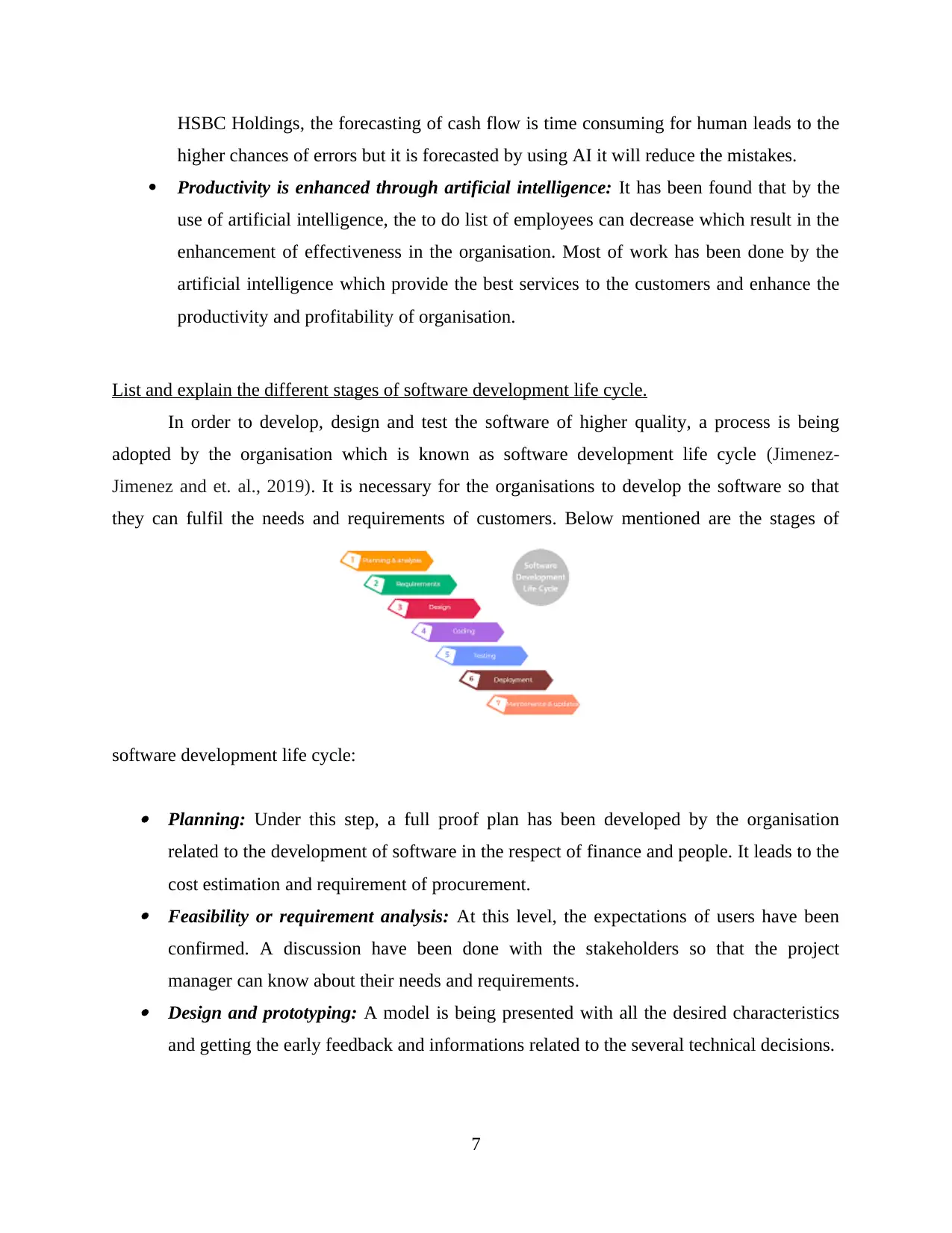
HSBC Holdings, the forecasting of cash flow is time consuming for human leads to the
higher chances of errors but it is forecasted by using AI it will reduce the mistakes.
Productivity is enhanced through artificial intelligence: It has been found that by the
use of artificial intelligence, the to do list of employees can decrease which result in the
enhancement of effectiveness in the organisation. Most of work has been done by the
artificial intelligence which provide the best services to the customers and enhance the
productivity and profitability of organisation.
List and explain the different stages of software development life cycle.
In order to develop, design and test the software of higher quality, a process is being
adopted by the organisation which is known as software development life cycle (Jimenez-
Jimenez and et. al., 2019). It is necessary for the organisations to develop the software so that
they can fulfil the needs and requirements of customers. Below mentioned are the stages of
software development life cycle:
Planning: Under this step, a full proof plan has been developed by the organisation
related to the development of software in the respect of finance and people. It leads to the
cost estimation and requirement of procurement. Feasibility or requirement analysis: At this level, the expectations of users have been
confirmed. A discussion have been done with the stakeholders so that the project
manager can know about their needs and requirements. Design and prototyping: A model is being presented with all the desired characteristics
and getting the early feedback and informations related to the several technical decisions.
7
higher chances of errors but it is forecasted by using AI it will reduce the mistakes.
Productivity is enhanced through artificial intelligence: It has been found that by the
use of artificial intelligence, the to do list of employees can decrease which result in the
enhancement of effectiveness in the organisation. Most of work has been done by the
artificial intelligence which provide the best services to the customers and enhance the
productivity and profitability of organisation.
List and explain the different stages of software development life cycle.
In order to develop, design and test the software of higher quality, a process is being
adopted by the organisation which is known as software development life cycle (Jimenez-
Jimenez and et. al., 2019). It is necessary for the organisations to develop the software so that
they can fulfil the needs and requirements of customers. Below mentioned are the stages of
software development life cycle:
Planning: Under this step, a full proof plan has been developed by the organisation
related to the development of software in the respect of finance and people. It leads to the
cost estimation and requirement of procurement. Feasibility or requirement analysis: At this level, the expectations of users have been
confirmed. A discussion have been done with the stakeholders so that the project
manager can know about their needs and requirements. Design and prototyping: A model is being presented with all the desired characteristics
and getting the early feedback and informations related to the several technical decisions.
7
⊘ This is a preview!⊘
Do you want full access?
Subscribe today to unlock all pages.

Trusted by 1+ million students worldwide
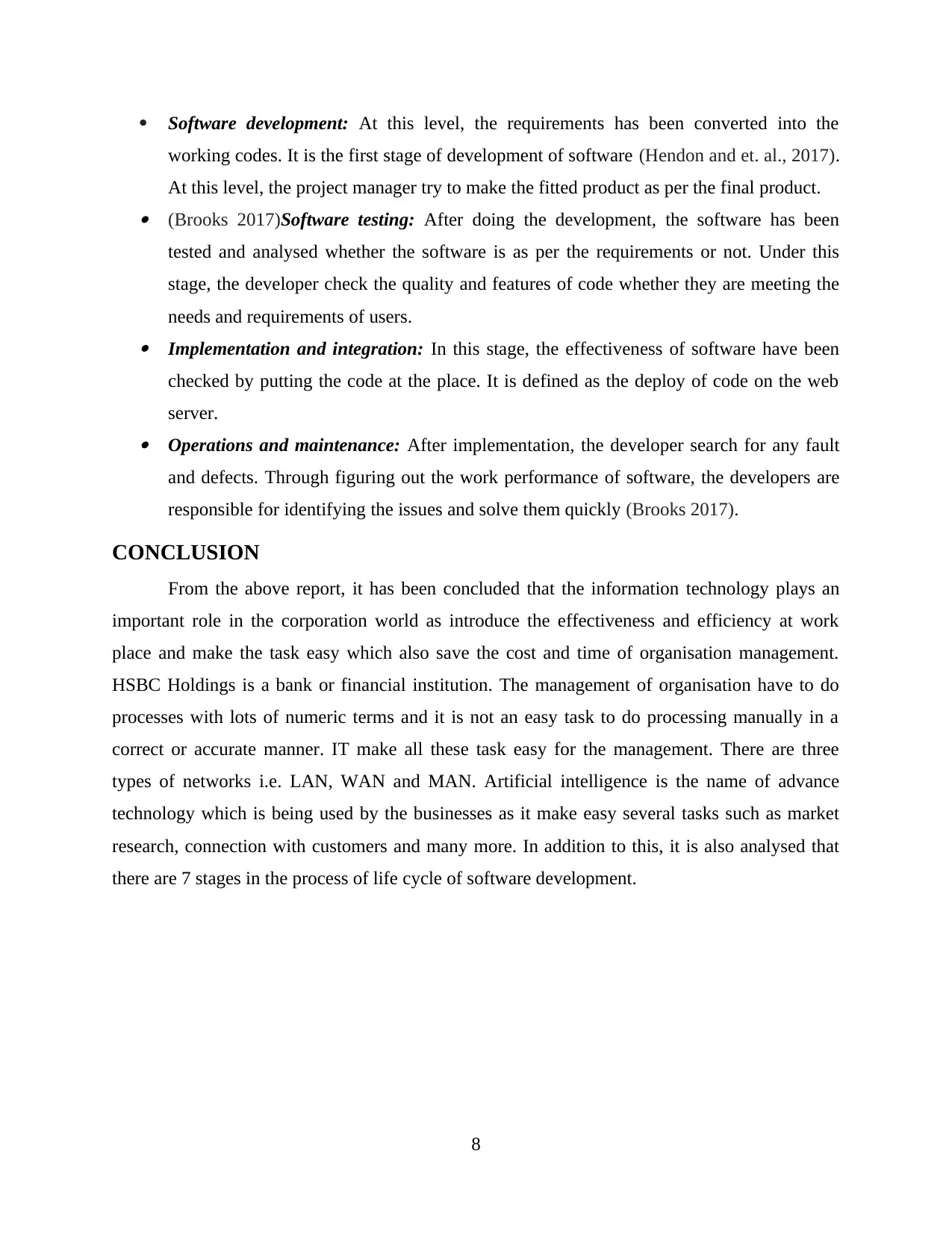
Software development: At this level, the requirements has been converted into the
working codes. It is the first stage of development of software (Hendon and et. al., 2017).
At this level, the project manager try to make the fitted product as per the final product. (Brooks 2017)Software testing: After doing the development, the software has been
tested and analysed whether the software is as per the requirements or not. Under this
stage, the developer check the quality and features of code whether they are meeting the
needs and requirements of users. Implementation and integration: In this stage, the effectiveness of software have been
checked by putting the code at the place. It is defined as the deploy of code on the web
server. Operations and maintenance: After implementation, the developer search for any fault
and defects. Through figuring out the work performance of software, the developers are
responsible for identifying the issues and solve them quickly (Brooks 2017).
CONCLUSION
From the above report, it has been concluded that the information technology plays an
important role in the corporation world as introduce the effectiveness and efficiency at work
place and make the task easy which also save the cost and time of organisation management.
HSBC Holdings is a bank or financial institution. The management of organisation have to do
processes with lots of numeric terms and it is not an easy task to do processing manually in a
correct or accurate manner. IT make all these task easy for the management. There are three
types of networks i.e. LAN, WAN and MAN. Artificial intelligence is the name of advance
technology which is being used by the businesses as it make easy several tasks such as market
research, connection with customers and many more. In addition to this, it is also analysed that
there are 7 stages in the process of life cycle of software development.
8
working codes. It is the first stage of development of software (Hendon and et. al., 2017).
At this level, the project manager try to make the fitted product as per the final product. (Brooks 2017)Software testing: After doing the development, the software has been
tested and analysed whether the software is as per the requirements or not. Under this
stage, the developer check the quality and features of code whether they are meeting the
needs and requirements of users. Implementation and integration: In this stage, the effectiveness of software have been
checked by putting the code at the place. It is defined as the deploy of code on the web
server. Operations and maintenance: After implementation, the developer search for any fault
and defects. Through figuring out the work performance of software, the developers are
responsible for identifying the issues and solve them quickly (Brooks 2017).
CONCLUSION
From the above report, it has been concluded that the information technology plays an
important role in the corporation world as introduce the effectiveness and efficiency at work
place and make the task easy which also save the cost and time of organisation management.
HSBC Holdings is a bank or financial institution. The management of organisation have to do
processes with lots of numeric terms and it is not an easy task to do processing manually in a
correct or accurate manner. IT make all these task easy for the management. There are three
types of networks i.e. LAN, WAN and MAN. Artificial intelligence is the name of advance
technology which is being used by the businesses as it make easy several tasks such as market
research, connection with customers and many more. In addition to this, it is also analysed that
there are 7 stages in the process of life cycle of software development.
8
Paraphrase This Document
Need a fresh take? Get an instant paraphrase of this document with our AI Paraphraser
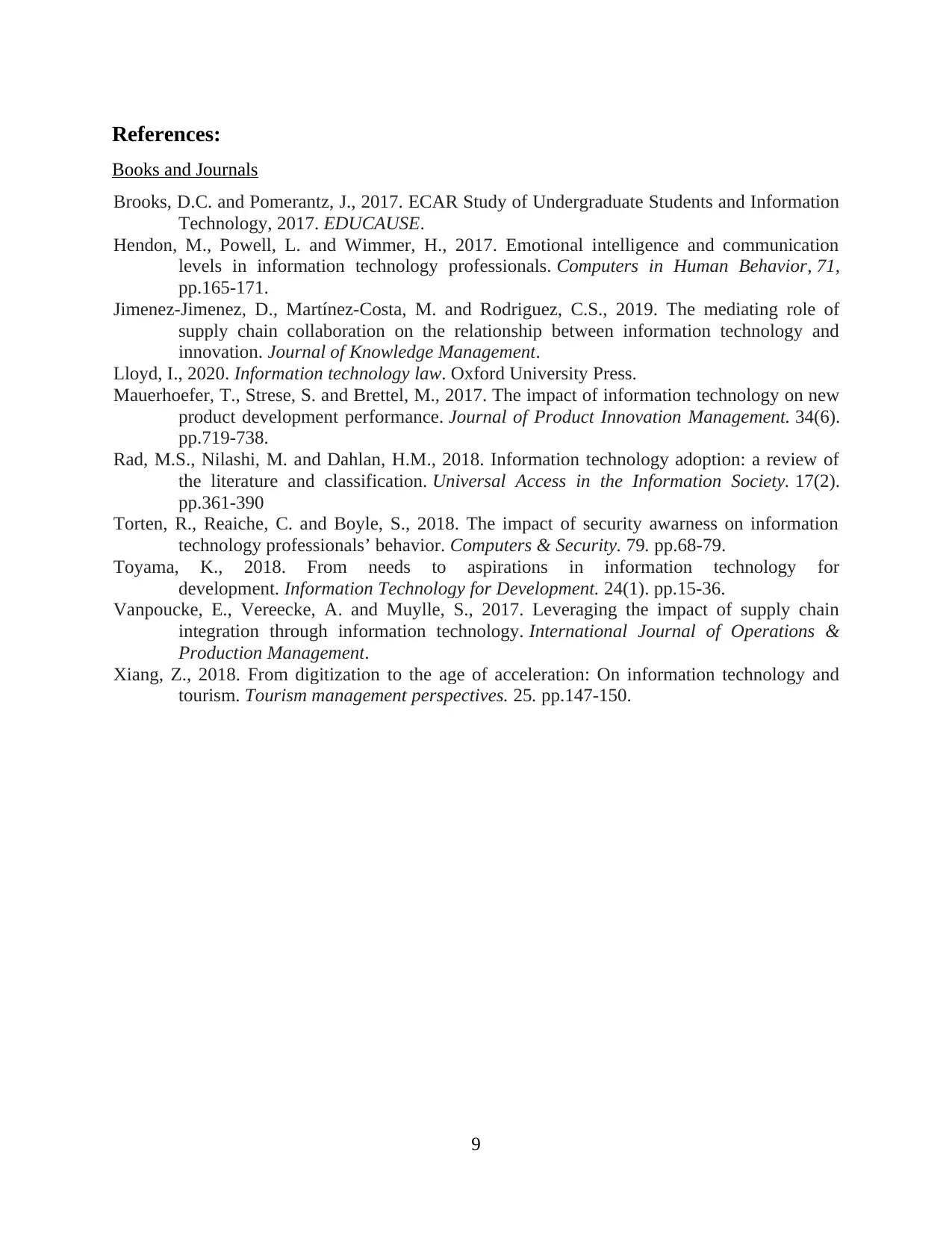
References:
Books and Journals
Brooks, D.C. and Pomerantz, J., 2017. ECAR Study of Undergraduate Students and Information
Technology, 2017. EDUCAUSE.
Hendon, M., Powell, L. and Wimmer, H., 2017. Emotional intelligence and communication
levels in information technology professionals. Computers in Human Behavior, 71,
pp.165-171.
Jimenez-Jimenez, D., Martínez-Costa, M. and Rodriguez, C.S., 2019. The mediating role of
supply chain collaboration on the relationship between information technology and
innovation. Journal of Knowledge Management.
Lloyd, I., 2020. Information technology law. Oxford University Press.
Mauerhoefer, T., Strese, S. and Brettel, M., 2017. The impact of information technology on new
product development performance. Journal of Product Innovation Management. 34(6).
pp.719-738.
Rad, M.S., Nilashi, M. and Dahlan, H.M., 2018. Information technology adoption: a review of
the literature and classification. Universal Access in the Information Society. 17(2).
pp.361-390
Torten, R., Reaiche, C. and Boyle, S., 2018. The impact of security awarness on information
technology professionals’ behavior. Computers & Security. 79. pp.68-79.
Toyama, K., 2018. From needs to aspirations in information technology for
development. Information Technology for Development. 24(1). pp.15-36.
Vanpoucke, E., Vereecke, A. and Muylle, S., 2017. Leveraging the impact of supply chain
integration through information technology. International Journal of Operations &
Production Management.
Xiang, Z., 2018. From digitization to the age of acceleration: On information technology and
tourism. Tourism management perspectives. 25. pp.147-150.
9
Books and Journals
Brooks, D.C. and Pomerantz, J., 2017. ECAR Study of Undergraduate Students and Information
Technology, 2017. EDUCAUSE.
Hendon, M., Powell, L. and Wimmer, H., 2017. Emotional intelligence and communication
levels in information technology professionals. Computers in Human Behavior, 71,
pp.165-171.
Jimenez-Jimenez, D., Martínez-Costa, M. and Rodriguez, C.S., 2019. The mediating role of
supply chain collaboration on the relationship between information technology and
innovation. Journal of Knowledge Management.
Lloyd, I., 2020. Information technology law. Oxford University Press.
Mauerhoefer, T., Strese, S. and Brettel, M., 2017. The impact of information technology on new
product development performance. Journal of Product Innovation Management. 34(6).
pp.719-738.
Rad, M.S., Nilashi, M. and Dahlan, H.M., 2018. Information technology adoption: a review of
the literature and classification. Universal Access in the Information Society. 17(2).
pp.361-390
Torten, R., Reaiche, C. and Boyle, S., 2018. The impact of security awarness on information
technology professionals’ behavior. Computers & Security. 79. pp.68-79.
Toyama, K., 2018. From needs to aspirations in information technology for
development. Information Technology for Development. 24(1). pp.15-36.
Vanpoucke, E., Vereecke, A. and Muylle, S., 2017. Leveraging the impact of supply chain
integration through information technology. International Journal of Operations &
Production Management.
Xiang, Z., 2018. From digitization to the age of acceleration: On information technology and
tourism. Tourism management perspectives. 25. pp.147-150.
9
1 out of 11
Related Documents
Your All-in-One AI-Powered Toolkit for Academic Success.
+13062052269
info@desklib.com
Available 24*7 on WhatsApp / Email
![[object Object]](/_next/static/media/star-bottom.7253800d.svg)
Unlock your academic potential
Copyright © 2020–2025 A2Z Services. All Rights Reserved. Developed and managed by ZUCOL.




